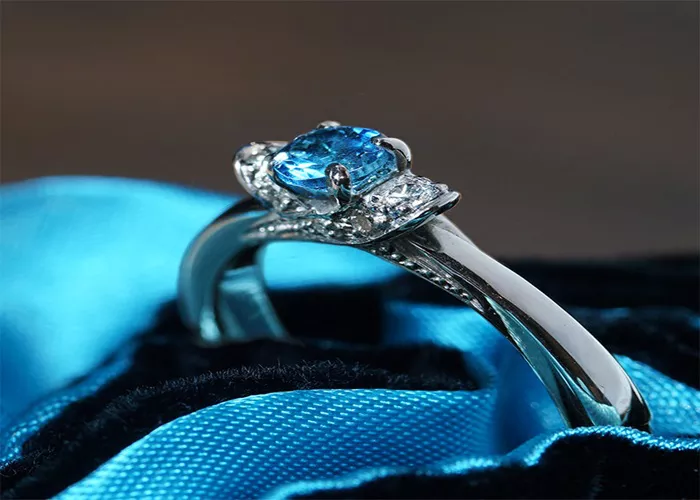Aquamarine is a beautiful gemstone known for its stunning blue or blue-green color. Many people love it for its calming and serene appearance. But when it comes to choosing a stone for an engagement ring, durability is a major concern. Engagement rings are worn every day, so the stone must withstand daily wear and tear. The question is: Is aquamarine hard enough for an engagement ring?
Understanding Gemstone Hardness
To answer this question, we must first understand gemstone hardness. Hardness is measured on the Mohs scale, which ranks minerals from 1 (softest) to 10 (hardest). The scale helps determine how resistant a stone is to scratches and abrasions. Diamonds, the hardest natural material, rank at 10. Other popular engagement ring stones like sapphires and rubies rank at 9.
Aquamarine is a variety of the mineral beryl, which has a hardness of 7.5 to 8 on the Mohs scale. This makes it a relatively hard gemstone, but not as hard as diamonds, sapphires, or rubies. For comparison, topaz has a hardness of 8, and quartz (like amethyst) ranks at 7.
How Does Aquamarine Compare to Other Engagement Ring Stones?
When choosing a stone for an engagement ring, hardness is crucial because rings are exposed to daily activities that can cause damage. Let’s compare aquamarine to other popular engagement ring stones:
- Diamond (10): Extremely hard, almost impossible to scratch under normal conditions.
- Sapphire/Ruby (9): Very durable, resistant to scratches, excellent for daily wear.
- Emerald (7.5-8): Same hardness as aquamarine, but more prone to chipping due to inclusions.
- Morganite (7.5-8): Another beryl gem, similar in hardness to aquamarine.
- Amethyst (7): Softer than aquamarine, more likely to scratch over time.
From this comparison, aquamarine is harder than some gemstones but not as tough as diamonds or sapphires.
Can Aquamarine Handle Daily Wear?
A hardness of 7.5 to 8 means aquamarine is reasonably durable, but it’s not indestructible. Here’s what you should consider:
Scratch Resistance
Aquamarine is resistant to scratches from materials with a lower Mohs rating, such as glass (5.5) or steel (6.5). However, common household dust contains tiny quartz particles (hardness 7), which can gradually scratch aquamarine over time.
Risk of Chipping
While aquamarine is hard, it can still chip if hit hard against a surface. Beryl stones like aquamarine and emerald have good hardness but lack the toughness of sapphires or diamonds. This means sharp impacts (like knocking the ring against a countertop) could cause cracks or chips.
Long-Term Wear
With proper care, an aquamarine engagement ring can last for years. However, it may show signs of wear over decades, especially if worn daily without precautions.
How to Protect an Aquamarine Engagement Ring
If you choose aquamarine for an engagement ring, you can take steps to protect it:
Choose a Protective Setting
A bezel or halo setting can shield the stone from impacts. A high setting (like a prong setting) exposes the stone more, increasing the risk of damage.
Avoid Harsh Activities
Remove the ring during heavy work, sports, or household chores. Even though aquamarine is durable, repeated knocks can weaken it over time.
Regular Cleaning and Maintenance
Clean the stone gently with mild soap and water. Avoid ultrasonic cleaners if the stone has inclusions, as vibrations can worsen cracks.
Periodic Professional Checkups
A jeweler can inspect the ring for loose settings or early signs of wear, helping prevent major damage.
Aquamarine vs. Traditional Engagement Ring Stones
Many couples opt for non-traditional engagement rings, and aquamarine is a beautiful choice. But how does it compare to classic options?
Aquamarine vs. Diamond
Diamonds are the hardest gemstone, making them nearly scratch-proof. Aquamarine, while beautiful, will show wear over time. However, aquamarine is much more affordable and offers a unique, soft blue hue that diamonds can’t match.
Aquamarine vs. Sapphire
Blue sapphires are a popular alternative to diamonds. They are harder (9 on the Mohs scale) and more scratch-resistant than aquamarine. However, sapphires are usually more expensive, and aquamarine provides a lighter, more delicate blue tone.
Aquamarine vs. Moissanite
Moissanite (9.25 on the Mohs scale) is harder than aquamarine and more durable for daily wear. However, moissanite has a different brilliance, and some prefer the natural look of aquamarine.
Who Should Choose an Aquamarine Engagement Ring?
Aquamarine is a great choice for certain people:
- Those who love its unique blue color and want a non-traditional ring.
- People who don’t mind some maintenance and are careful with jewelry.
- Those who prefer a larger stone at a more affordable price.
However, if you want a stone that requires minimal care and will look pristine for decades, a harder gem like sapphire or diamond may be better.
Conclusion
Aquamarine is a beautiful and meaningful gemstone, but its hardness (7.5-8) means it’s not as durable as diamonds or sapphires. With proper care and the right setting, it can still make a stunning engagement ring. If you love its color and are willing to take precautions, aquamarine is a wonderful choice. But if you want maximum durability, you might consider a harder stone. Ultimately, the best engagement ring is one that reflects your personal style and lifestyle.
Related Topics:
- The Beauty of a 14K Gold Aquamarine Ring
- The Allure of the Aquamarine Ring: A Timeless Treasure in the Diamond Store
- What is Aquamarine Marquise?


